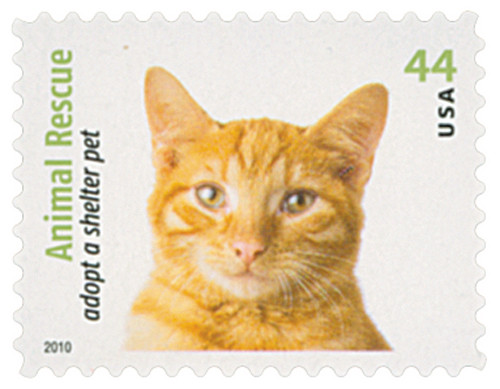
2010 44c Adopt a Shelter Pet: Gray and White Cat
# 4456 - 2010 44c Adopt a Shelter Pet: Gray and White Cat
$0.50 - $3.95
U.S. #4456
Animal Rescue
Animal Rescue
Issue Date: April 30, 2010
City: North Hollywood, CA
Printing Method: Lithographed
Perforations: Serpentine Die Cut 10.75
Color: Multicolor
City: North Hollywood, CA
Printing Method: Lithographed
Perforations: Serpentine Die Cut 10.75
Color: Multicolor
Levi came to the shelter in bad shape, with ears bloody from scratching ear mites and possibly from fights. He was one of the lucky ones. Captured from a colony of feral cats in a suburban neighborhood, soon he was neutered, vaccinated, and offered for adoption. After about a week, he was saved. His new home is filled with love for their new addition. His ears are still sensitive, but he loves belly rubs, back scratches, and his new family life.
Feral cats are often overlooked as the root of the cat overpopulation epidemic. Feral cats are the wild offspring of domestic cats. In 2004, approximately 70 million feral cats lived in the U.S. It’s a problem that continues to grow. By some estimates, one breeding pair will produce over 400,000 kittens in seven years.
Eliminating feral cat populations is impossible. If one colony is removed, another will migrate into its territory. With a constant supply of feral cats, “trap and kill” programs failed in the past. Although it is a daunting task, spaying and neutering to prevent future litters is the only program that shows progress.
Feral cats adopted from shelters have been spayed or neutered to prevent future litters. Once placed in their new homes, these once-wild cats can make lovable pets and enjoyable companions.
U.S. #4456
Animal Rescue
Animal Rescue
Issue Date: April 30, 2010
City: North Hollywood, CA
Printing Method: Lithographed
Perforations: Serpentine Die Cut 10.75
Color: Multicolor
City: North Hollywood, CA
Printing Method: Lithographed
Perforations: Serpentine Die Cut 10.75
Color: Multicolor
Levi came to the shelter in bad shape, with ears bloody from scratching ear mites and possibly from fights. He was one of the lucky ones. Captured from a colony of feral cats in a suburban neighborhood, soon he was neutered, vaccinated, and offered for adoption. After about a week, he was saved. His new home is filled with love for their new addition. His ears are still sensitive, but he loves belly rubs, back scratches, and his new family life.
Feral cats are often overlooked as the root of the cat overpopulation epidemic. Feral cats are the wild offspring of domestic cats. In 2004, approximately 70 million feral cats lived in the U.S. It’s a problem that continues to grow. By some estimates, one breeding pair will produce over 400,000 kittens in seven years.
Eliminating feral cat populations is impossible. If one colony is removed, another will migrate into its territory. With a constant supply of feral cats, “trap and kill” programs failed in the past. Although it is a daunting task, spaying and neutering to prevent future litters is the only program that shows progress.
Feral cats adopted from shelters have been spayed or neutered to prevent future litters. Once placed in their new homes, these once-wild cats can make lovable pets and enjoyable companions.















